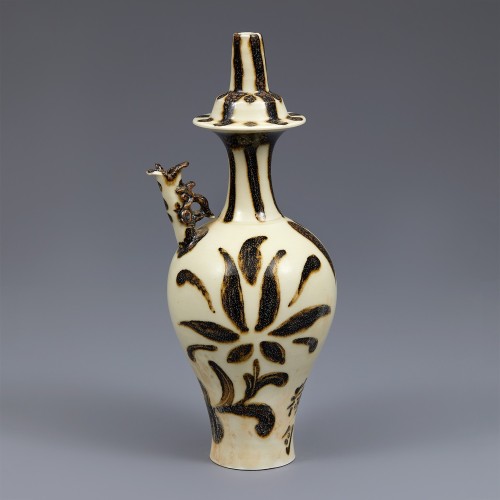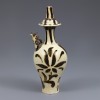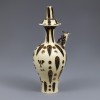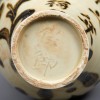본문
좁고 긴 목 위에 원반형 마디와 물을 넣는 첨대가 있는 정병입니다. 정병은 불교 용구 중 하나로 감로수(甘露水)나 깨끗한 물(淨水)을 담는 병입니다. 팽만한 어깨에서 곡선을 이루며 하단으로 좁아지는 형태입니다. 어깨에는 용머리를 닮은 형상의 주구(注口)가 붙어있습니다. 굽은 편평하며 굽바닥에 供御(공어)라는 관지가 새겨져 있습니다. 관지를 통해 이 유물이 황제를 위하여 만들어졌음을 알 수 있습니다.
동체 중앙에는 荷月 皇祐 二年 甲一(하월 황우 이년 갑일)이라는 관지가 있습니다. 황우(1049~1054)는 송나라 인종의 일곱 번째 연호로 황우 2년은 1050년입니다. 하월은 여름을 의미하므로 이 유물의 제작 시기는 1050년 6월경으로 추정됩니다. 그 뒤편에는 커다란 꽃이 그려져 있고 목과 첨대, 동체 전반에는 점과 선이 수직을 이뤄 반복적으로 시문되었습니다. 주구의 용머리와 입도 철화로 채색되었습니다. 이 유물은 정요에서 제작되었으며 정요는 송대 5대 명요 (여요, 관요, 가요, 균요, 정요) 중 한 곳으로 황실용 자기를 제작하던 곳입니다.
This ewer has a narrow, elongated neck topped with a disc-shaped collar and a spout for pouring water. The jingping (净甁) was one of the ritual vessels used in Buddhism, designed to hold ambrosial water (ganlu shui) or pure water. Its form swells at the shoulders before tapering downwards, and attached to the shoulder is a spout in the shape of a dragon’s head. The base is flat, and on its underside is an imperial mark reading gongyu (供御, “for imperial use”), indicating that this piece was produced for the emperor.
At the center of the body, there is an inscription that reads Heyue Huangyou Ernian Jiayi (荷月 皇祐 二年 甲一), dating the piece to the second year of the Huangyou reign (1049–1054) under Emperor Renzong of Song, specifically around the summer month of June 1050. On the back, a large floral motif is painted, while the neck, collar, and body are decorated with vertical rows of dots and lines in repeated patterns. The dragon-head spout and its mouth are also painted in iron brown.
This ewer was produced at the Ding kiln, one of the Five Great Kilns of the Song dynasty (Ru, Guan, Ge, Jun, and Ding), which were renowned for producing porcelain for imperial use.






